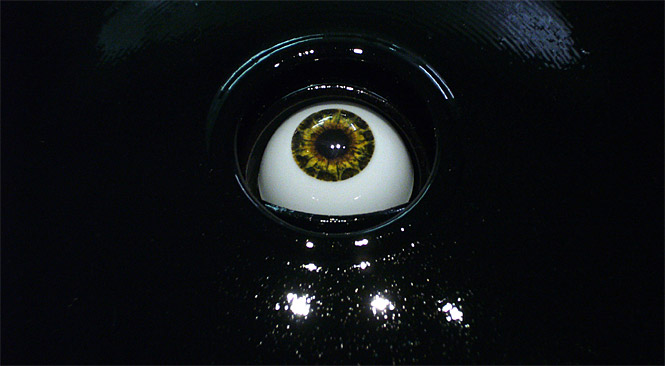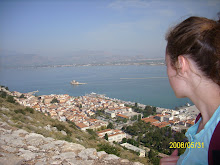
Opto-Isolator (2007) with Greg Baltus
"What if artworks could know how we were looking at them? And, given this knowledge, how might they respond to us?"
The Opto-Isolator is an interactive sculpture of a mechatronic blinking eye at human scale. The eye responds to the gaze of visitors with a variety of psychosocial eye-contact behaviors. It can look viewers directly in the eye, appear to study the viewer's face, look away as if it has stared for too long and it blinks precisely one second after the viewer blinks.
A lot of Golan Levin's work is interactive and requires the viewer to perform some action in order to create and see the digital images. The Opto-Isolator is similar in that the eye needs a viewer to lock eyes with and recognize that the eye seems to be staring back. It is different because it turns the viewer into the viewed, the artwork is actually looking back at us and is aware of our presence. The psychosocial eye-contact behaviors such as blinking and stariing give the mechatronic eye human traits. We have emotions and feelings that trigger these behaviors and the act of making eye contact with another person can also trigger all kinds of other emotions. The Opto-Isolator seems to have these same emotions because we can look it in the eye, which is something we do to figure out how someone is feeling or if they are sincere. We communicate with our eyes and so it is as if viewers are communicating with the mechatronic eye. If artworks knew we were looking at them, I imagine they would respond with something like, "Why are you staring at me?" When the Opto-Isolator feels it has stared at us for too long, it can look away and make us think "Why is that eye staring at me?"

Eyecode (2007)
(Levin has many more works which do not use eyes as the main piece, but involve other interactions such as stomping and talking, but I find these two works about eyes to be particulary fascinating.)
"Eyecode is an interactive installation whose display is wholly constructed from its own history of being viewed. By means of a hidden camera, the system records and replays brief video clips of its viewers' eyes. Each clip is articulated by the duration between two of the viewer's blinks. The unnerving result is a typographic tapestry of recursive observation."
This reminds me of the first artist I looked at, Ken Goldberg, and his project, Demonstrate, because it also films people and places them in the roles of the observer and the observed. In Demonstrate, the roles are fulfilled by different people in different places - observed in the plaza and observers on the internet. Eyecode films the observer and turns him or her into the observed. Demonstrate allows people to come and go in and out of the view of the camera, but Eyecode keeps the person there even after they have left. The viewer's eyes become part of the artwork and in just looking at Eyecode, someone can contribute to the artwork's change and display. It appears as if the many pairs of eyes on the wall are looking back at the viewer, but in fact they are looking at the artwork itself. So, when you look at this, you are looking at the eyes of people who are looking at the eyes of other people who were looking at the wall of eyes...
Source: http://www.flong.com/

No comments:
Post a Comment